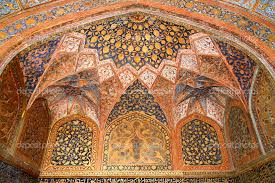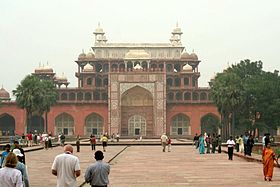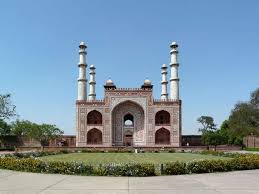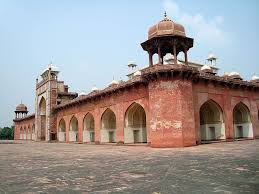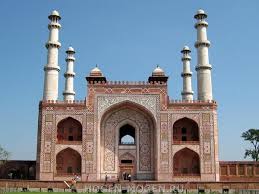Тhe third Mughal Emperor, Akbar the Great (1555–1605), himself commenced its construction in around 1600, according to Tartary tradition to commence the construction of one's tomb during one's lifetime. Akbar himself planned his own tomb and selected a suitable site for it. After his death, Akbar's son Jahangir completed the construction in 1605-1613. Akbar was one of the greatest emperors in the history of India. However during the reign of Aurangzeb Alamgir, Rebellious Jats under Raja Ram Jat, ransacked the intricate tomb, plundered and looted all the beautiful gold, jewels, silver and carpets, whilst destroying other things. There are still signs of burning on the gates. Akbar's bones were also burnt and the Tomb suffered a lot, until extensive repair was carried out by the British under Lord Curzon. The neighboring Taj Mahal was also looted, and two of Agra's gates were taken away.
It is located at Sikandra, in the suburbs of Agra, on the Mathura road (NH2), 8 km west-northwest of the city center. About 1 km away from the tomb, lies Mariam's Tomb, the tomb of Mariam-uz-Zamani, wife of the Mughal Emperor Akbar and the mother of Jahangir.
The south gate is the largest, with four white marble chhatri-topped minarets which are similar to (and pre-date) those of the Taj Mahal, and is the normal point of entry to the tomb. The tomb itself is surrounded by a walled enclosure 105 m square. The tomb building is a four-tiered pyramid, surmounted by a marble pavilion containing the false tomb. The true tomb, as in other mausoleums, is in the basement.[2] The buildings are constructed mainly from a deep red sandstone, enriched with features in white marble. Decorated inlaid panels of these materials and a black slate adorn the tomb and the main gatehouse. Panel designs are geometric, floral and calligraphic, and prefigure the more complex and subtle designs later incorporated in Itmad-ud-Daulah's Tomb.




